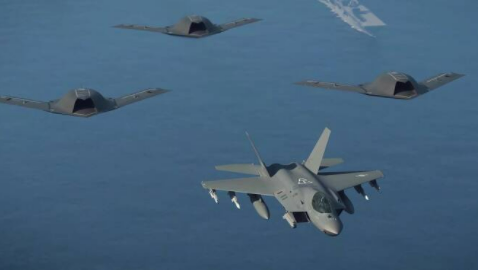Increasing the SPACE SECURITY Power and Its Challenges for the Republic of Korea Air Force in the Era of the Fourth ..
Military
Views. 1784
Abstract
Purpose: The main purpose of this article is to explore aerospace power development strategies promoted by the Republic of Korea Air Force(ROKAF), and to examine the necessity and tasks of strengthening space power, focusing on the main content of Air Force Quantum 5.0, an innovative task for ROKAF from the perspective of smart national defense innovation in the Fourth Industrial Revolution(4IR) era. The main contents of the 4IR and the concept of space power dealt with in Air Force Quantum 5.0 were set as the scope of research.Method: For better analysis, as part of case studies, the article is to analyze literature with a focus on research analysis materials regarding the concept of the Fourth Industrial Revolution, policy reports on Air Force Quantum 5.0 promoted by the ROKAF, and academic papers.
Results: It is required for the ROKAF to establish an advanced power system for aerospace operations in response to future warfare, such as securing key leading technologies for weapon systems using 4IR technologies, identifying military capabilities and core forces, reflecting them in the future force integration, and promoting civil-military R&D cooperation systems. It also needs to establish a space command and take the lead in the future joint battlefield area in order to establish itself as a space powerhouse like the surrounding powers, including the United States and China.
Conclusion: This article concluded that in order for the ROKAF to further respond to uncertain security threats, consider work innovation and combat power enhancement, overcome increasing challenge factors such as the deepening shortages of military service resources, and adapt to the future battle field environment, advanced 4IR technologies should be applied in all branches of the air force to ensure the military remains sophisticated and intelligent, and to speed up the promotion of high-efficient aerospace operation systems and defense operation environment.
[Keywords] Era of the Fourth Industrial Revolution, Defense Innovation, Space Security, Aerospace Power, Air Force Quantum 5.0
References
[1] Hwang SI. A Study on the Development Plans of Cyber Electronic Warfare for the Advancement of Aerospace Forces. Journal of Military Science Research, 71(1), 39-40 (2020).
[2] Shin YD. Is There an Arms Race between South and North Korea?. International Journal of Justice & Law, 1(2), 9-15 (2016). [Article]
[3] Kim J. Future Warfare and Artificial Intelligence Applications in the ROK Military: Problems and Alternatives. Robotics & Ethics, 6(2), 11-20 (2021). [Article]
[5] Christopher C. Artificial Intelligence and the Future of War. Scandinavian Journal of Military Studies, 2(1), 55-60 (2019).
[6] Krepon M. Space as a Strategic Asset Twilight War: The Folly of U.S Space Dominance, and the Politics of Space Security: Strategic Restraint and the Pursuit of National Interests. Nonproliferation Review, 15(3), 549-554 (2008).
[7] Fabio T & Hao L. The Trump Administration and Outer Space: Promoting US Leadership or Heading towards Isolation?. Australian Journal of International Affairs, 72(5), 418-432 (2018).
[9] Yun JW. Characteristics and Sustainability of Russian Military Reforms: Focusing on Putin’s Fourth Presidential Term and National Security Strategies. The Korean Journal of Area Studies, 36(3), 83-104 (2018).
[10] Lee SS. Suggestions for ROK’s Building Space Power as Public Values. Public Value, 6(1), 14-37 (2021). [Article]
[11] Hazelton JI. Drone Strikes and Grant Strategy: Toward a Political Understanding of the Uses of the Uses of Unmanned Aerial Vehicle Attacks in US Security Policy. Journal of Strategic Studies, 40(1-2), 78-80 (2017).
[13] Cho HJ & Park GY. North Korea Missile: Past, Present and Future. International Journal of Terrorism & National Security, 3(1), 1-5 (2018). [Article]
[14] Lee SS. A Case Study of AI Defense Applications in Major Northeast Asian States and Strategies for Building a ROK’S AI-based National Defense System. International Journal of Terrorism & National Security, 6(1), 1-13 (2021). [Article]
[16] Patrick B & Esther C. Military Space Developments: Challenges and Opportunities for Defense and Industry, Hague Center for Strategic Studies. The Hague Centre for Strategic Studies Security Snapshot, 12(16), 3-3 (2020).
[17] Rendleman JD. A Strategy for Space Assurance. Astropolitics, 8, 220-255 (2010).
[18] Park GY. Arms Control in the Korean Peninsula: Opportunities and Limitations. Public Value, 5(1), 29-38 (2020). [Article]
[8] Seol HJ. National Space Development Policy and the Role of Air Force’ Industry-academia Collaboration Foundation. Chungnam National University (2019).
[15] The ROKAF. Future Aerospace Power Development Initiative to Prepare for the 100th Anniversary of Its Foundation(Air Force Quantum 5.0). ROKAF (2020).
[4] Park BK. East Asia’s Space Military Power Construction Trends and ROK’s Response Directions. INSS Research Report (2020).
[12] McCall SM. National Security Space Launch. CRS Report (2020).

? Source: news.heraldcorp.com
